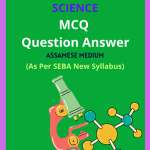Class 8 Science MCQ Chapter 18 Pollution of Air and Water Solutions in English Medium, Class 8 Science Multiple Choice Question Answer in English to each chapter is provided in the list so that you can easily browse throughout different chapters Class 8 Science MCQ Chapter 18 Pollution of Air and Water Notes and select need one.
Class 8 Science MCQ Chapter 18 Pollution of Air and Water
Also, you can read the SCERT book online in these sections Class 8 Science Objective Type Solutions by Expert Teachers as per SCERT (CBSE) Book guidelines. These solutions are part of SCERT All Subject Solutions. Here we have given Assam Class 8 Science MCQs Solutions in English for All Subject, You can practice these here.
Pollution of Air and Water
Chapter – 18
| MCQ |
1. The Taj Mahal is being affected due to:
(a) Noise pollution.
(b) Air pollution.
(c) Water pollution.
(d) None of these.
Ans. (b) Air pollution.
2. Air pollution causes:
(a) Global warming.
(b) Respiratory diseases.
(c) Soil erosion.
(d) None of these.
Ans. (b) Respiratory diseases.
3. Greenhouse gas is:
(a) Nitrogen.
(b) Oxygen.
(c) Methane.
(d) Carbon dioxide.
Ans. (d) Carbon dioxide.
4. Which disease can be possible due to polluted water?
(a) Cholera.
(b) Typhoid.
(c) Jaundice.
(d) All the above.
Ans. (d) All the above.
5. Corrosion of marble is also called:
(a) Marble-disorder.
(b) Marble-erosion.
(c) Marble cancer.
(d) Marvellous.
Ans. (c) Marble cancer.
6. Which of the following is not a greenhouse gas?
(a) carbon dioxide.
(b) nitrous oxide.
(c) methane.
(d) nitrogen.
Ans. (d) nitrogen.
7. The constituent of polluted air which contributes in producing acid rain is:
(a) nitrogen.
(b) sulphur dioxide.
(c) oxygen.
(d) argon.
Ans. (b) sulphur dioxide.
8. The Kyoto protocol is associated with one of the following. This one is:
(a) reduction in the use of chlorofluoro carbons
(b) reduction in the emission of greenhouse gases.
(c) reduction in the cutting of forest trees.
(d) reduction in pollution of fresh water sources.
Ans. (b) reduction in the emission of greenhouse gases.
9. Drinking water can be made absolutely safe by adding some:
(a) aspirin tablets.
(b) iodine tablets.
(c) chlorine tablets.
(d) chlorophyll tablets.
Ans. (c) chlorine tablets.
10. The excessive use of one of the following in agriculture can cause the death of fish in a pond by oxygen starvation. This one is:
(a) fertilizers.
(b) manures.
(c) pesticides.
(d) herbicides.
Ans. (a) fertilizers.
11. Which of the following is a primary source of air pollution?
(a) Forest fires.
(b) Agricultural activities.
(c) Industrial emissions.
(d) All of the above.
Ans: (d) All of the above.
12. What is the major effect of particulate matter (PM) on human health?
(a) Respiratory problems.
(b) Digestive issues.
(c) Skin diseases.
(d) Hearing loss.
Ans: (a) Respiratory problems.
13. Which gas is primarily responsible for the greenhouse effect?
(a) Nitrogen.
(b) Oxygen.
(c) Carbon dioxide.
(d) Argon.
Ans: (c) Carbon dioxide.
14. What is acid rain caused by?
(a) High humidity.
(b) Low temperatures.
(c) Emissions of sulphur dioxide and nitrogen oxides.
(d) Solar radiation.
Ans: (c) Emissions of sulphur dioxide and nitrogen oxides.
15. Which of the following is a common pollutant in water bodies?
(a) Sulphur dioxide.
(b) Ozone.
(c) Heavy metals.
(d) Carbon monoxide.
Ans: (c) Heavy metals.

Hi! my Name is Parimal Roy. I have completed my Bachelor’s degree in Philosophy (B.A.) from Silapathar General College. Currently, I am working as an HR Manager at Dev Library. It is a website that provides study materials for students from Class 3 to 12, including SCERT and NCERT notes. It also offers resources for BA, B.Com, B.Sc, and Computer Science, along with postgraduate notes. Besides study materials, the website has novels, eBooks, health and finance articles, biographies, quotes, and more.




